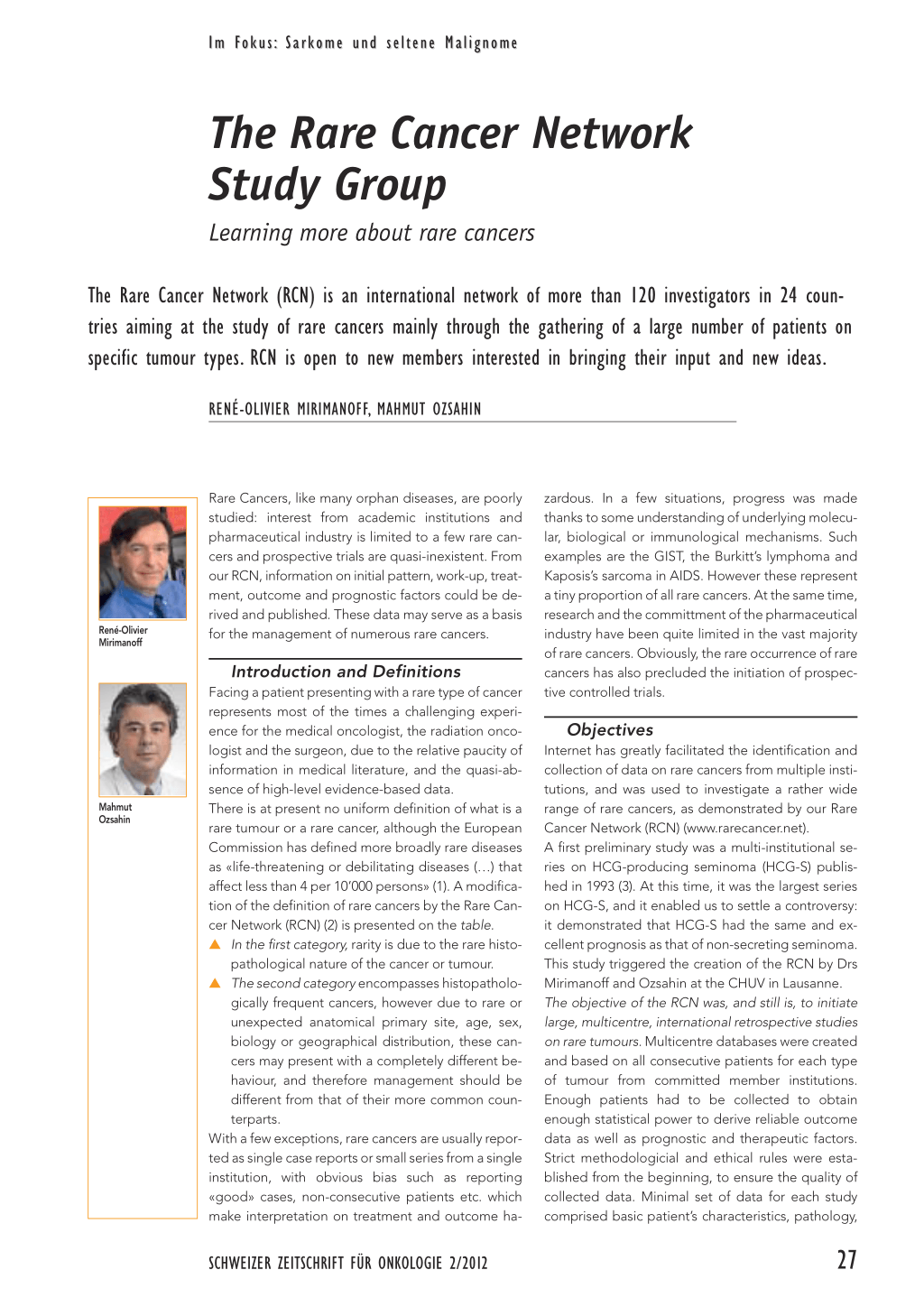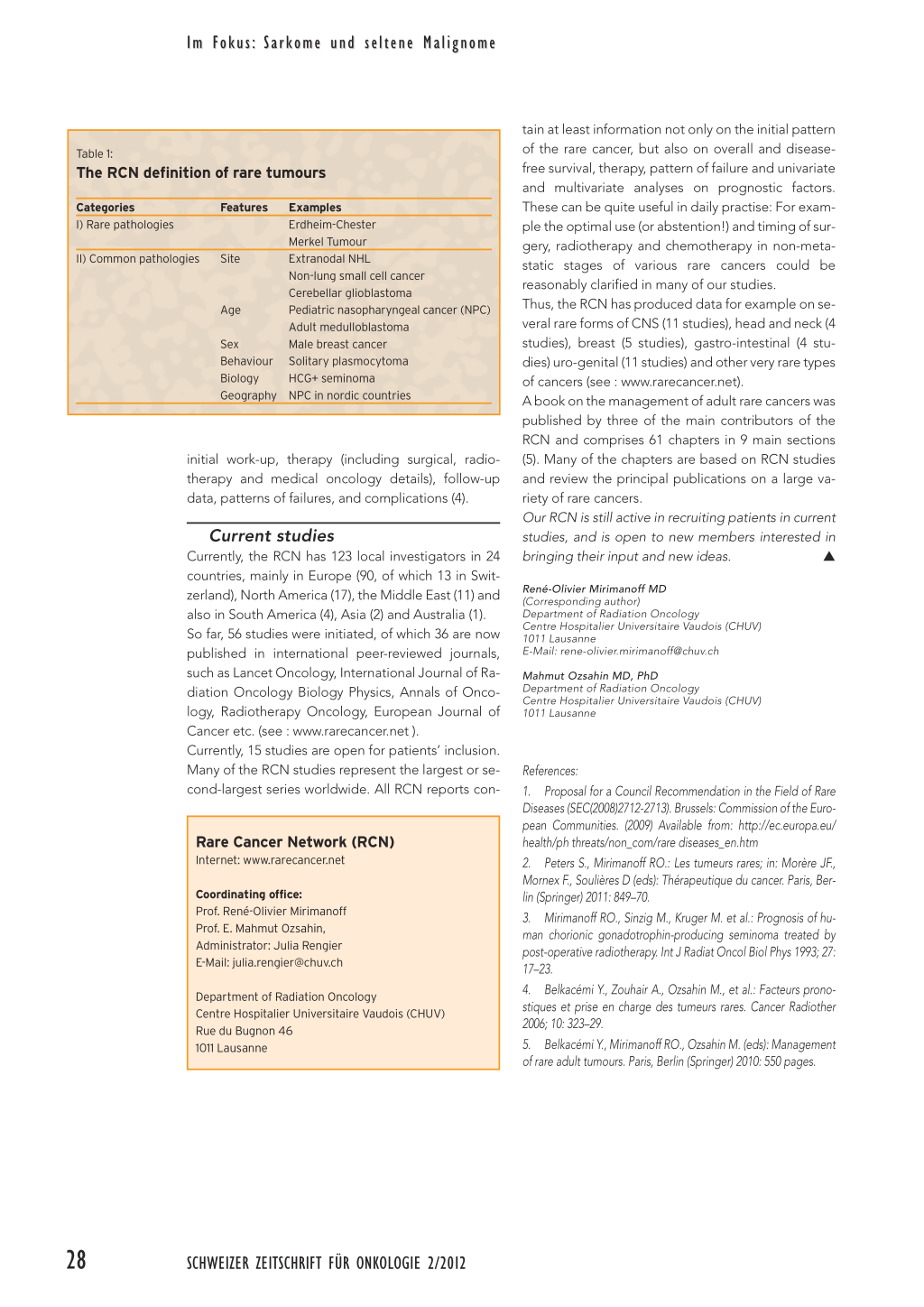Transkript
Im Fokus: Sarkome und seltene Malignome
The Rare Cancer Network Study Group
Learning more about rare cancers
The Rare Cancer Network (RCN) is an international network of more than 120 investigators in 24 countries aiming at the study of rare cancers mainly through the gathering of a large number of patients on specific tumour types. RCN is open to new members interested in bringing their input and new ideas.
RENÉ-OLIVIER MIRIMANOFF, MAHMUT OZSAHIN
René-Olivier Mirimanoff
Mahmut Ozsahin
Rare Cancers, like many orphan diseases, are poorly studied: interest from academic institutions and pharmaceutical industry is limited to a few rare cancers and prospective trials are quasi-inexistent. From our RCN, information on initial pattern, work-up, treatment, outcome and prognostic factors could be derived and published. These data may serve as a basis for the management of numerous rare cancers.
Introduction and Definitions
Facing a patient presenting with a rare type of cancer represents most of the times a challenging experience for the medical oncologist, the radiation oncologist and the surgeon, due to the relative paucity of information in medical literature, and the quasi-absence of high-level evidence-based data. There is at present no uniform definition of what is a rare tumour or a rare cancer, although the European Commission has defined more broadly rare diseases as «life-threatening or debilitating diseases (…) that affect less than 4 per 10’000 persons» (1). A modification of the definition of rare cancers by the Rare Cancer Network (RCN) (2) is presented on the table. ▲ In the first category, rarity is due to the rare histo-
pathological nature of the cancer or tumour. ▲ The second category encompasses histopatholo-
gically frequent cancers, however due to rare or unexpected anatomical primary site, age, sex, biology or geographical distribution, these cancers may present with a completely different behaviour, and therefore management should be different from that of their more common counterparts. With a few exceptions, rare cancers are usually reported as single case reports or small series from a single institution, with obvious bias such as reporting «good» cases, non-consecutive patients etc. which make interpretation on treatment and outcome ha-
zardous. In a few situations, progress was made thanks to some understanding of underlying molecular, biological or immunological mechanisms. Such examples are the GIST, the Burkitt’s lymphoma and Kaposis’s sarcoma in AIDS. However these represent a tiny proportion of all rare cancers. At the same time, research and the committment of the pharmaceutical industry have been quite limited in the vast majority of rare cancers. Obviously, the rare occurrence of rare cancers has also precluded the initiation of prospective controlled trials.
Objectives
Internet has greatly facilitated the identification and collection of data on rare cancers from multiple institutions, and was used to investigate a rather wide range of rare cancers, as demonstrated by our Rare Cancer Network (RCN) (www.rarecancer.net). A first preliminary study was a multi-institutional series on HCG-producing seminoma (HCG-S) published in 1993 (3). At this time, it was the largest series on HCG-S, and it enabled us to settle a controversy: it demonstrated that HCG-S had the same and excellent prognosis as that of non-secreting seminoma. This study triggered the creation of the RCN by Drs Mirimanoff and Ozsahin at the CHUV in Lausanne. The objective of the RCN was, and still is, to initiate large, multicentre, international retrospective studies on rare tumours. Multicentre databases were created and based on all consecutive patients for each type of tumour from committed member institutions. Enough patients had to be collected to obtain enough statistical power to derive reliable outcome data as well as prognostic and therapeutic factors. Strict methodologicial and ethical rules were established from the beginning, to ensure the quality of collected data. Minimal set of data for each study comprised basic patient’s characteristics, pathology,
SCHWEIZER ZEITSCHRIFT FÜR ONKOLOGIE 2/2012
27
Im Fokus: Sarkome und seltene Malignome
Table 1:
The RCN definition of rare tumours
Categories I) Rare pathologies
II) Common pathologies
Features
Site
Age Sex Behaviour Biology Geography
Examples Erdheim-Chester Merkel Tumour Extranodal NHL Non-lung small cell cancer Cerebellar glioblastoma Pediatric nasopharyngeal cancer (NPC) Adult medulloblastoma Male breast cancer Solitary plasmocytoma HCG+ seminoma NPC in nordic countries
initial work-up, therapy (including surgical, radiotherapy and medical oncology details), follow-up data, patterns of failures, and complications (4).
Current studies
Currently, the RCN has 123 local investigators in 24 countries, mainly in Europe (90, of which 13 in Switzerland), North America (17), the Middle East (11) and also in South America (4), Asia (2) and Australia (1). So far, 56 studies were initiated, of which 36 are now published in international peer-reviewed journals, such as Lancet Oncology, International Journal of Radiation Oncology Biology Physics, Annals of Oncology, Radiotherapy Oncology, European Journal of Cancer etc. (see : www.rarecancer.net ). Currently, 15 studies are open for patients’ inclusion. Many of the RCN studies represent the largest or second-largest series worldwide. All RCN reports con-
Rare Cancer Network (RCN)
Internet: www.rarecancer.net
Coordinating office: Prof. René-Olivier Mirimanoff Prof. E. Mahmut Ozsahin, Administrator: Julia Rengier E-Mail: julia.rengier@chuv.ch
Department of Radiation Oncology Centre Hospitalier Universitaire Vaudois (CHUV) Rue du Bugnon 46 1011 Lausanne
tain at least information not only on the initial pattern
of the rare cancer, but also on overall and disease-
free survival, therapy, pattern of failure and univariate
and multivariate analyses on prognostic factors.
These can be quite useful in daily practise: For exam-
ple the optimal use (or abstention!) and timing of sur-
gery, radiotherapy and chemotherapy in non-meta-
static stages of various rare cancers could be
reasonably clarified in many of our studies.
Thus, the RCN has produced data for example on se-
veral rare forms of CNS (11 studies), head and neck (4
studies), breast (5 studies), gastro-intestinal (4 stu-
dies) uro-genital (11 studies) and other very rare types
of cancers (see : www.rarecancer.net).
A book on the management of adult rare cancers was
published by three of the main contributors of the
RCN and comprises 61 chapters in 9 main sections
(5). Many of the chapters are based on RCN studies
and review the principal publications on a large va-
riety of rare cancers.
Our RCN is still active in recruiting patients in current
studies, and is open to new members interested in
bringing their input and new ideas.
▲
René-Olivier Mirimanoff MD (Corresponding author) Department of Radiation Oncology Centre Hospitalier Universitaire Vaudois (CHUV) 1011 Lausanne E-Mail: rene-olivier.mirimanoff@chuv.ch
Mahmut Ozsahin MD, PhD Department of Radiation Oncology Centre Hospitalier Universitaire Vaudois (CHUV) 1011 Lausanne
References:
1. Proposal for a Council Recommendation in the Field of Rare Diseases (SEC(2008)2712-2713). Brussels: Commission of the European Communities. (2009) Available from: http://ec.europa.eu/ health/ph threats/non_com/rare diseases_en.htm
2. Peters S., Mirimanoff RO.: Les tumeurs rares; in: Morère JF., Mornex F., Soulières D (eds): Thérapeutique du cancer. Paris, Berlin (Springer) 2011: 849–70.
3. Mirimanoff RO., Sinzig M., Kruger M. et al.: Prognosis of human chorionic gonadotrophin-producing seminoma treated by post-operative radiotherapy. Int J Radiat Oncol Biol Phys 1993; 27: 17–23.
4. Belkacémi Y., Zouhair A., Ozsahin M., et al.: Facteurs pronostiques et prise en charge des tumeurs rares. Cancer Radiother 2006; 10: 323–29.
5. Belkacémi Y., Mirimanoff RO., Ozsahin M. (eds): Management of rare adult tumours. Paris, Berlin (Springer) 2010: 550 pages.
28 SCHWEIZER ZEITSCHRIFT FÜR ONKOLOGIE 2/2012

